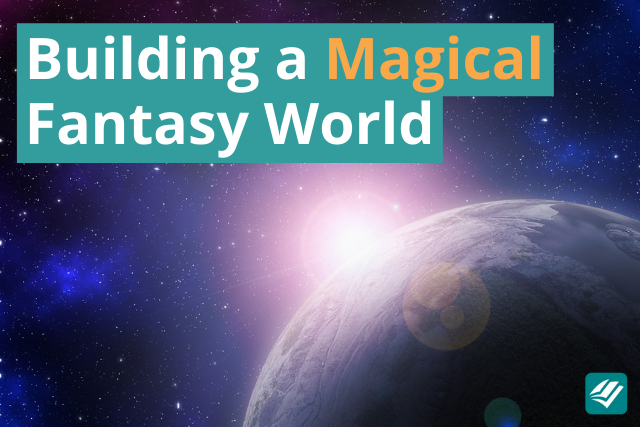
Some imaginary worlds are so detailed and immersive that they almost feel as real as our own.
In our mind’s eyes, we’ve dined with hobbits in Middle Earth, attended magic classes at Hogwarts, and fought villains in the Marvel Universe.
What did those authors do to make their imaginary worlds so compelling? And how do you build a detailed world like that for your own story?
Read on to learn how to create a unique fictional world that your readers can get lost in.
Learn How to Build Awe-Inspiring Worlds at Fantasy Writers' Week
- Four free days of live events, just for fantasy writers
- Write, plan, and learn with us live with workshops, write-ins, and interviews
- Hear from bestselling authors and educators like V.E. Schwab and Tomi Adeyemi
On to the article!
What Is Worldbuilding in a Story?
Worldbuilding is the process of developing a fictional setting for a novel or short story.
Every fiction writer will need to do some amount of worldbuilding, whether they need to invent a single apartment or an all-encompassing multiverse.
If you write fantasy or science fiction, worldbuilding can be incredibly complex. You might need to develop the history of dragons, the linguistics of a whole new language, or even new laws of physics.
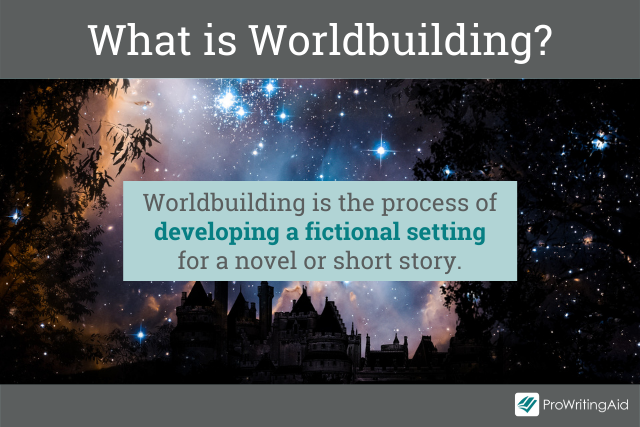
What Are the Different Types of Worldbuilding?
There are two types of worldbuilding: primary world and secondary world.
Primary worlds are worlds similar to some version of the real world, while secondary worlds aren't set on Earth at all.
Primary world worldbuilding is necessary for stories that are set in a slightly different version of the Earth we know.
You’ll need to build a primary world if you write in the following sub-genres:
- Contemporary fantasy, which is fantasy set in the present day (e.g. Harry Potter by J.K. Rowling, The Magicians by Lev Grossman, American Gods by Neil Gaiman)
- Alternate histories, which explores what might have happened if historical events had differed from what happened in reality (e.g. The Man in the High Castle by Philip K. Dick, United States of Japan by Peter Tieryas, The Calculating Stars by Mary Robinette Kowal)
- Apocalyptic science fiction, which describe cataclysmic events that end society as we know it (e.g. The Road by Cormac McCarthy, Station Eleven by Emily St. John Mandel, Oryx and Crake by Margaret Atwood)
- Any other story set on a version of Earth
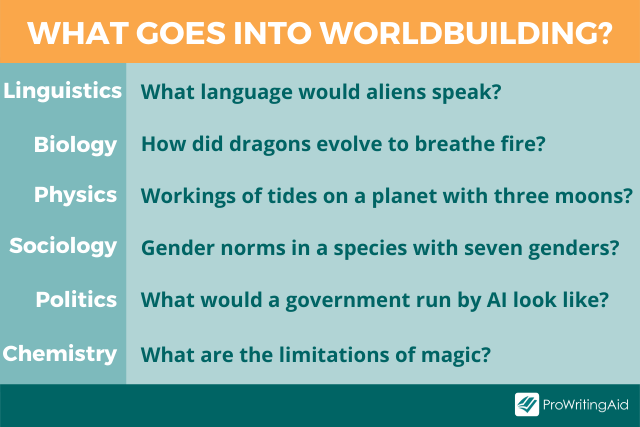
Secondary world worldbuilding is necessary for stories that are set on an entirely different planet from the real world, or maybe even something that’s not a planet at all.
You’ll need to build a secondary world if you write in the following sub-genres:
- Epic fantasy, which is set in an entirely fictional fantasy world (e.g. The Lord of the Rings by J.R.R. Tolkien, A Game of Thrones by George R.R. Martin, A Wizard of Earthsea by Ursula K. LeGuin)
- Space empire/space opera science fiction, which span multiple planets or even multiple galaxies (e.g. Star Wars, Star Trek, A Memory Called Empire by Arkady Martine)
- Portal fantasy, where characters in the real world get transported to fictional worlds (e.g. The Chronicles of Narnia by C.S. Lewis, Alice’s Adventures in Wonderland by Lewis Carroll, The Ten Thousand Doors of January by Alix E. Harrow)
- Any other story set on a world completely different from Earth
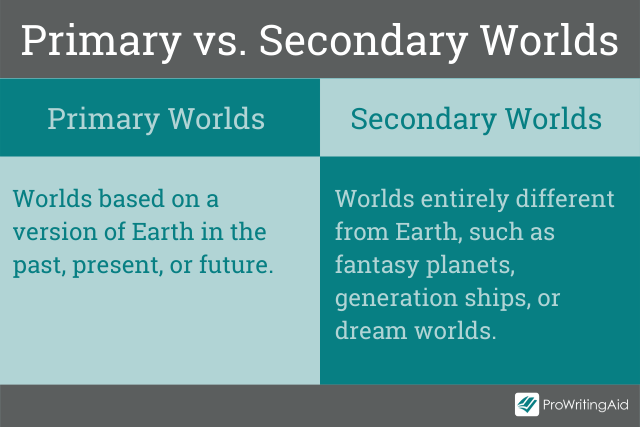
Worldbuilding Brainstorming Techniques
The secret to good worldbuilding is to make it feel like there’s a whole world you’ve developed, even if you only show a few details of it.
You can’t actually invent a whole world from scratch, of course—that would take centuries to accomplish—but you can give the reader a few well-placed details that make it feel as though this world has a lot of depth.
Picture a high-definition photo with a blurry background. A single very real moment in the foreground can make the reader feel like the background exists in just as much detail, even if the background is just a set of smudges.
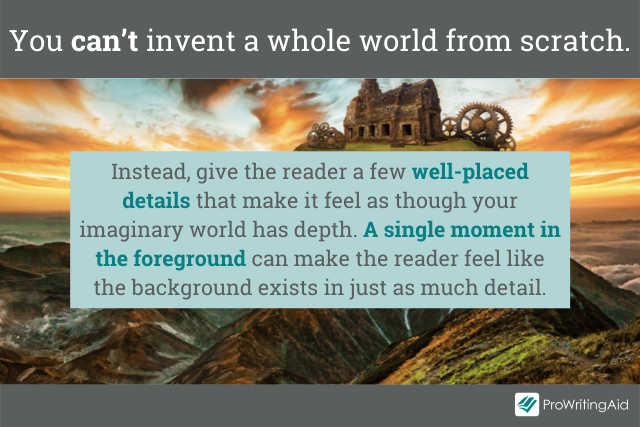
One useful tip is to start from a single important change and see how many effects that makes on the world. Let’s call this change the Seed.
For example, say your story is set on a world exactly like ours, except people have always been able to fly. That's the Seed for their world. How many effects could that lead to?
Here are some possible effects that could sprout from that Seed alone:
- Instead of the swearwords we use, their swearwords might relate to flight and/or falling
- People might build floating societies, where the upper-class literally lives at the top and the lower-class literally lives at the bottom
- Children might look forward to a rite of passage in which they take their first solo flight, the way children look forward to getting their driver’s license in our world
Starting with a single Seed is often more effective than coming up with a thousand different ideas and trying to merge them together into a cohesive whole.
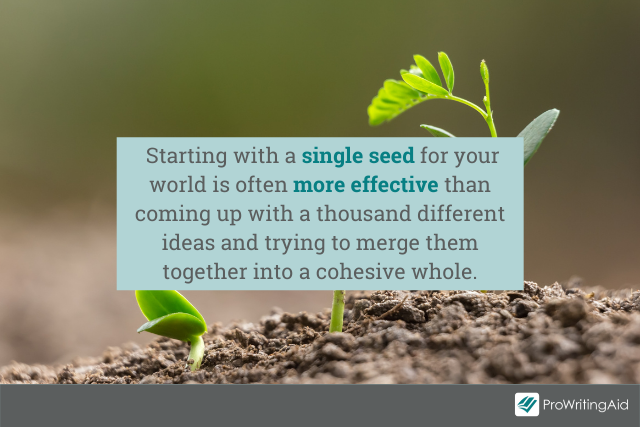
When you start from one source, everything holds together logically, and it feels like there’s a lot of depth to your world even if you haven’t fully fleshed it out.
What Are the Key Elements of Worldbuilding?
Once you’ve decided on your Seed, there are countless types of effects you can consider. I’ve compiled some of the most important ones into a list of questions.
Here’s a list of detailed elements that you can use to brainstorm your fantasy or science fiction world.
Geographical Elements
If you’re building a secondary world, you can start with the planet itself. This is a piece that many fantasy writers often skip, but it has so much potential in the fantasy genre.
Setting your story on a different planet—or not on a planet at all—leads to all kinds of interesting effects.
The Planet
- Does your world exist on a planet at all, or is it somewhere else (e.g. a spaceship, a flat disc, an astral plane)?
- If you have a planet, how big is the planet? How strong is its gravity?
- How long are the days in your world? The years?
The Geography
- Are there continents on this planet? What do they look like?
- Do the continents have rivers, mountains, deserts? (Tip: It can help to draw a tectonic map, to see where these structures would naturally occur)
- Are there natural disasters on this planet?
The Flora and Fauna
- What kinds of climates exist on this planet?
- What kinds of plants and animals live in each climate?
- Which species in your world are considered “people”? Are there talking plants, sentient spaceships, etc.?
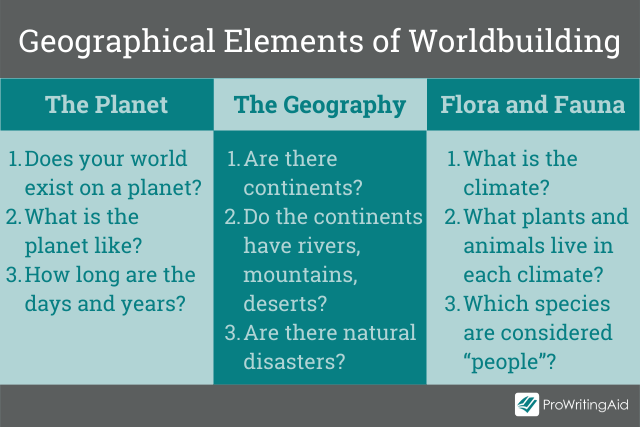
Societal Elements
Whether you’re building a primary world or a secondary world, there will likely be elements of your fictional societies that are different from the real world.
Building a new society and culture is one of the most exciting parts of worldbuilding.
If your book spans more than one society, you’ll want to do this for each group of people that the readers will meet.
Food
- What do they eat? Do different social classes eat different things?
- Where does their food come from? Who grows it?
- How many meals do they eat each day? What are their dining customs?
Language
- What does their language sound like (or look like, or taste like, or smell like)?
- What names do they have? Are their names based on real words? Does everyone have one name, or a first name and a family name, or something else entirely?
- What kind of slang and swearwords do they use?
Families
- Who do they live with? (e.g. friends, parents, spouses, business partners)
- Is there marriage in this society? Who decides each individual’s marital partner(s)?
- How does reproduction and parenthood work?
Economy
- What kind of currency do they use?
- What natural resources are considered valuable? Why?
- What kind of economic system do they have? Is it capitalist, communist, socialist, or something else entirely?
Social Roles
- How many genders are there? What are the different roles each gender is expected to play?
- How much social inequality is there?
- How much social mobility is there? Can a lower-class person join the upper classes by acquiring money, education, or some other resource?
Government
- Who holds power in this society?
- Who decides who holds power in this society? Is it a democracy, a monarchy, an oligarchy, or something else entirely?
- Are there any threats to this balance of power?
Religion
- Are there gods in this world? Do they interact with people?
- What kind of religious practices or rituals does this society have?
- What are the creation stories of this society? How do they believe they came here?
Technology / Magic
- What machines and tools do these people use?
- Can people wield magic? How does the magic system work?
- Who has access to these machines, tools, and magic? Can everyone use them or are they restricted in some way?
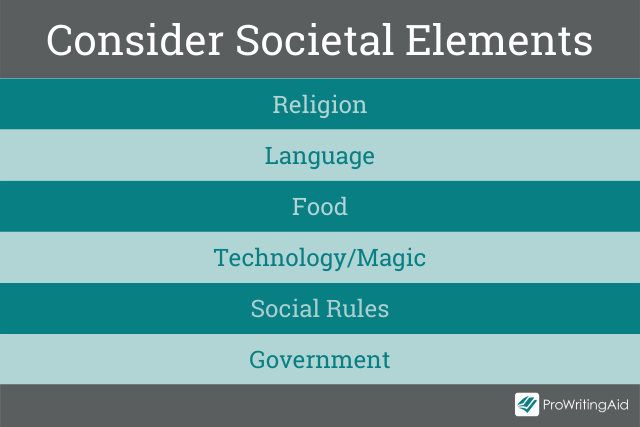
What Are Some Common Worldbuilding Mistakes?
There are several mistakes that many beginner fantasy and science fiction writers make. I personally have been guilty of all of these at some point in my writing journey.
Of course, none of these “don’t”s are set in stone—if you really want to do one of these things, there are ways to pull them off well.
But as a general rule, these mistakes tend to hurt your story more than they help it.
Mistake #1: Borrowing an existing fantasy world, instead of creating something new.
There are countless fantasy worlds that are just rehashed versions of The Lord of the Rings, complete with J.R.R. Tolkien’s vision of elves, orcs, and dwarves.
You might be thinking, The Lord of the Rings was amazing, so what’s wrong with reusing it?
Well, for one thing, it’s a wasted opportunity. You could come up with a creative and original world that would make your story stand out from the crowd.
Also, copying existing fantasy worlds also means that your story will come inherent with the perspectives those authors had.
For example, J.R.R. Tolkien’s fantasy species reflect some of the racial prejudices of his time, which are prejudices you might not want to perpetuate.
Unless you build your own fictional world, you will never be able to imbue it with your own authentic perspective and fresh ideas.
It’s okay to take inspiration from other authors’ worlds, but you should always find a way to make it your own, instead of copying it outright.
Mistake #2: Using disparate details that don’t belong together.
Maybe you have three unique ideas for a magical world: talking volcanoes, underwater dragons, and strong matriarchies. So you throw all three together into a single book.
But how do these three things interact with each other? What was the chain of cause-and-effect that led to them all existing in the same place?
Most of the time, readers will get confused when you throw too many disconnected details into your world, because you didn’t come up with a logical enough reason for all those things to coexist. Carefully consider how each thing affects everything else.
With worldbuilding, sometimes less is more. Considering interconnections before you add new elements will add so much logical cohesion and depth to your story.
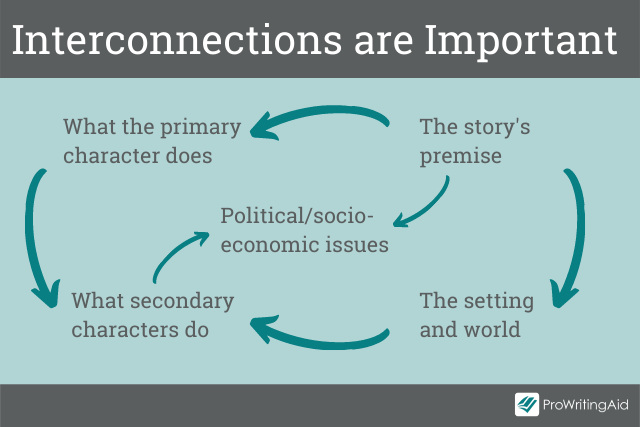
Mistake #3: Spending too much time on worldbuilding details that don’t serve the story.
At the end of the day, what makes a great novel is the story, not the setting.
Worldbuilding is a great servant, but a bad master.
If you’re twisting your story to suit the details of the world, rather than developing the details of the world to suit the story, you might want to shift your priorities.
Prioritize the details you develop based on what will matter to the plot and to the protagonist.
Don’t include a five-paragraph essay on the history of dragons in your world, no matter how interesting that history is, if none of that information has anything to do with the main plot.
Be ruthless when deciding what does and doesn’t belong in your novel.
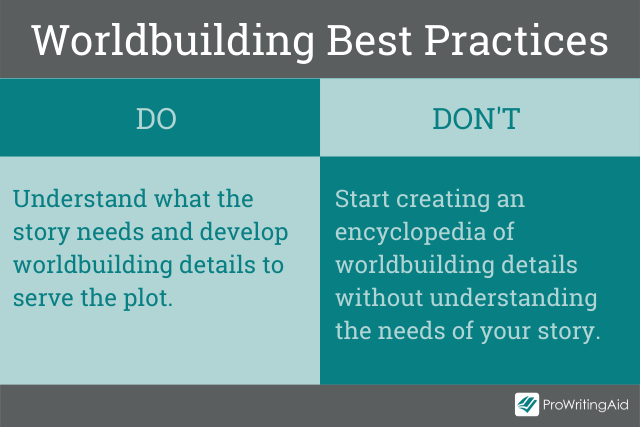
Mistake #4: Making your imaginary world too static.
How many science fiction worlds have you seen where a single regime has ruled for the past thousand years?
Everything is uniform, everything is static, and everyone is somehow happy with the way things are.
This is common in fiction, but impossible in the real word.
Look around at your neighborhood right now, wherever you live—or your city, or your country, or your planet—and think about how much your own world has changed in your lifetime.
A good fictional world should always be evolving. You should give some thought to your imaginary world’s history, not just what it looks like today.

Mistake #5: Failing to consider all five senses.
People experience the world in different ways. Imagine yourself in a busy marketplace. You would simultaneously see the stalls, hear the chatter of the shoppers and calls of vendors, smell the food being cooked on a stall, and feel the heat of the day.
But if you only describe a setting using one sense, it can feel one-dimensional. Check that you have included a variety of sensory elements when describing your setting using ProWritingAid’s Sensory Report.
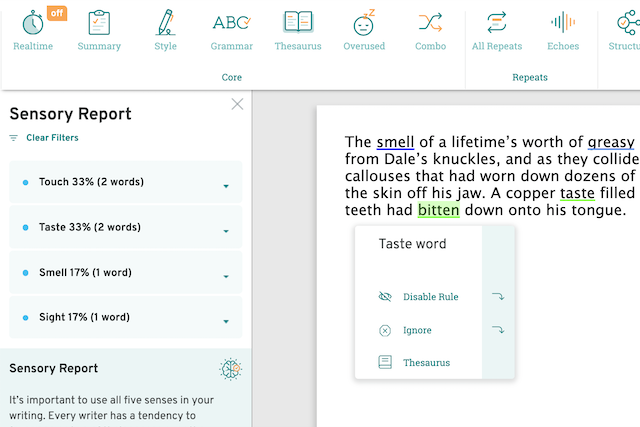
When you upload your writing ad run the report, it will give you a rundown of how many of each type of sensory word you have used so you can make sure you've got a balance.
Try the Sensory Report now with a free account.
Now that we’ve talked about common mistakes to avoid, let’s look at some examples of worlds in literature that are fresh and unique.
Examples of Great Worldbuilding in Fantasy and Science Fiction
Let’s look at some examples of fantastic worldbuilding from beloved fantasy and science fiction stories.
The Planet Arrakis in Dune by Frank Herbert
Dune is a classic masterclass in worldbuilding. The books are set on multiple planets, each of which feel like worlds of their own.
Frank Herbert was fascinated by ecology, and as a result, he did an incredible job developing the ecological details of his worlds.
The Seed for Arrakis is that it’s a desert planet, on which water is extremely scarce.
The Fremen, the native inhabitants of this planet, have built their entire culture around the task of surviving in a water-scarce place.
Some worldbuilding details that stem from this Seed:
- The Fremen wear stillsuits that collect and repurpose their bodies’ water so they can drink the liquid they sweat, urinate, and exhale.
- Instead of using coins, their currency takes the form of “water rings,” which represent their personal ownership of moisture, because water is more valuable than gold on this planet.
- In Fremen culture, spitting at someone is considered a sign of enormous generosity and respect, because of how valuable water is. This almost causes a deadly misunderstanding in one scene of the story, when an outsider from another planet assumes that being spit at is an insult.
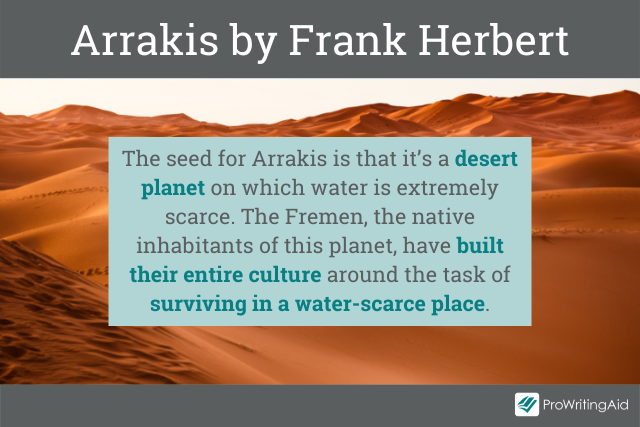
The Continent Called the Stillness in The Broken Earth Trilogy by N.K. Jemisin
The Broken Earth is one of the most intricate and unique worldbuilding systems in the fantasy genre.
The Seed for the Stillness is that the planet has a lot more tectonic activity than our planet does, with frequent earthquakes and tsunamis.
As a result, the people who live on the Stillness essentially live on a planet that keeps trying to kill them.
This is what caused their magic system and system of societal oppression to evolve.
Some worldbuilding details that stem from this Seed:
- The sciences most valuable in the Stillness are fields like geomestry and biomestry, which combine the study of geology with other important fields of study to help scientists manage the tectonic activity.
- Orogenes, who have the magical ability of controlling the earth, are named after rocks (e.g. Syenite, Alabaster, Feldspar).
- Swearwords on the Stillness include “evil Earth” (since their planet often tries to kill them), “rusting Earth” (since rust weakens buildings and causes them to collapse in earthquakes) and “earthfire!” (which refers to volcanoes and magma).
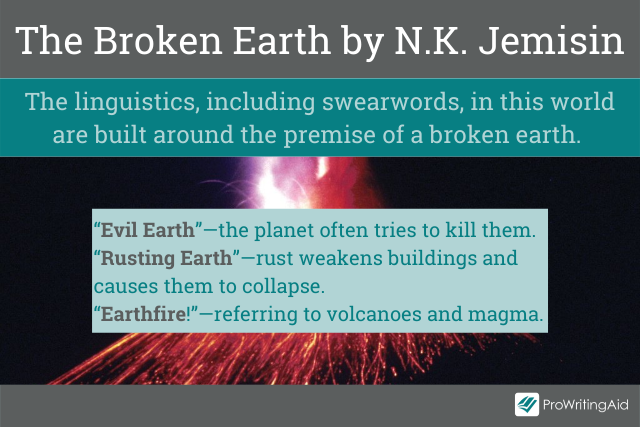
The Republic of Gilead in The Handmaid’s Tale by Margaret Atwood
The Handmaid’s Tale is a classic dystopia. But while some dystopias come into existence just because evil people craved power, the Republic of Gilead came into existence to protect a single valuable resource.
This choice gives the story an incredible amount of logical cohesion and believability.
The Seed for Gilead is that female fertility rates have gone down drastically.
As a result, fertile women are considered the most valuable resource, and women are subjugated under a totalitarian theocracy.
Some worldbuilding details that stem from this Seed:
- Women are assigned societal functions (Wives, Marthas, Aunts, or Handmaids) and must dress in the assigned colors of their role.
- Handmaids are named after the men they serve. The main characters include Offred who serves Fred, Ofglen who serves Glen, and Ofwarren who serves Warren.
- The far-right movement that created the Republic of Gilead is called the Sons of Jacob, a reference to the Biblical story of Jacob and Rachel, which was the inspiration for the role played by the Handmaids
Build An Immersive Fantasy World
And there you have it: a comprehensive guide to building your own fantasy world.
If you enjoy making maps and timelines, I highly recommend trying World Anvil, which offers a variety of free worldbuilding tools.
What element of worldbuilding is your favorite to brainstorm? Have you come up with any creative details for your own fantasy worlds?
Let us know in the comments.
If you love writing fantasy, this is the event for you.
- Learn from bestselling authors and educators in live sessions
- Master outlining, writing, editing, publishing and more
- Meet like-minded fantasy writers in networking events




